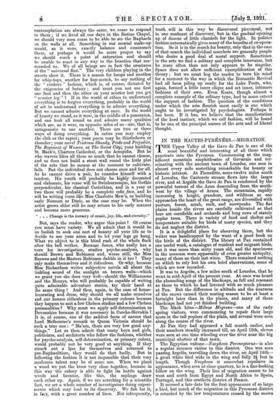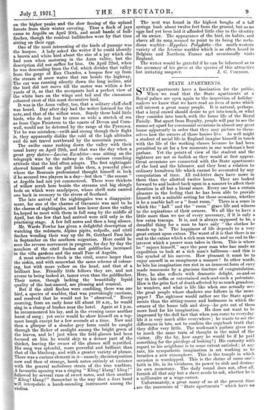IN THE HAUTES-PYRENEES.—MIGRATION. T HE Upper Valley of the Gave de
Pau is one of the most beautiful and interesting of all those which penetrate into the Pyrenees. Commencing at the mag- nificent mountain amphitheatre of Gavarnie and ter- minating with the ancient town of Lourdes, one sees in almost every mile something remarkable for beauty or historic interest. At Pierrefitte, some twelve miles south of Lourdes, the Cauterets stream flows into the larger river, and at Argeles the Gave de Pau is reinforced by the powerful torrent of the Azun descending from the south- west by the village • of Aruns. The mountains, rapidly increasing in height, grandeur, and wildness as one approaches the heart of the great range, are diversified with pasture, forest, scrub, rock, and snowpeaks. The flat plains beside the rivers are carefully cultivated so that here are cornfields and orchards and long rows of stately poplar trees. There is variety of food and shelter and temperature suitable for birds of many species, and they do not neglect the district. It is a delightful place for observing them, but the writer was handicapped by the want of a good book on the birds of the district. The library at Pau contained one useful work, a catalogue of resident and migrant birds, but it was more than sixty years old, and the specimens in the museum were apparently of even greater antiquity, many of them on their last wires. There remained nothing on which to rely but his own brief observations, some of which are now recorded.
It was to Argeles, a few miles south of Lourdes, that he went in mid-April of the present year. At once was heard the abounding songs of the blackcaps, as full and resonant as those to which he had listened with so much pleasure at Pau. But the difference in altitude and the nearness of the snows caused their nesting season to be at least a fortnight later than in the plains, and many of these blackcaps had not yet finished building. The black kites—Mt-Jew Migrans—one of the early i spring visitors, were commencing to repair their large nests n the tall poplars of the plain, and several were seen along the course of the river. At Pau they had appeared a full month earlier, and their numbers steadily increased till, on April 12th, eleven were seen at one time wheeling over the river near the big municipal abattoir of that town.
The Egyptian vulture—Neophron Percnopterus—is also a regular summer visitor to this district. One was seen passing Argeles, travelling down the river, on April 14th— a great white bird wide in the wing and fully 2i feet in length. Though Neophran is somewhat repulsive in appearance, when seen at close quarters, he is a fine-looking fellow on the wing. Their line of migration seems to be west and north from Egypt and North Africa to Spain, Portugal, and this southern district of France. It seemed a late date for the first appearance of so large a bird, but much of the migration in this Pyrenean district is retarded by the low temperatures caused by the snows on the -higher -peaks -and- the slow freeing of the upland forests from their winter covering. Thus a flock of jays came to Argeles on April 20th, and Small bands of bull- finches, though the resident -bullfinches were by that time sitting on their eggs. One of the most interesting of the birds of passage was the hoopoe. A lady asked the writer if he could identify a brown and white bird about the size of a jay which she had seen when motoring in the Azun valley, but the description did not suffice for him. On April 22nd, when he was descending from the Col, which divides that valley from the gorge of Eux Chaudes, a hoopoe flew up from the stream of snow water that ran beside the highway. The car was running silently down the long incline, and the bird did not move till the motor was within a few yards of it, so that the occupants had a perfect view of the white bars on the wings and tail and the cinnamon coloured crest of this most decorative bird.
It was in the Azun valley, too, that a solitary chill-chaff was heard. Day after day had the writer listened for the note, and that of the willow wren. Surely these bold little birds, who do not fear to cross so wide a stretch of sea as from Cape Finisterre to the coasts of Devon and Corn- wall, would not be deterred by the range of the Pyrenees. Yet he was mistaken—swift and strong though their flight is, they apparently dislike the cold of the high altitudes and do not travel northward by the mountain passes.
The swifts came rushing down the valley with their usual hurry on April 25th, and that was the day when a great grey shrive—Lanius Excubitor—was sitting on the telegraph wire by the railway in the curious crouching attitude that the bird often adopts. The first nightingale showed- himself on the golf links then, a peaceful place where the Bearnais professional thought himself in luck if he secured two players in a day—but then " the season" at Argeles had not yet. commenced. There were thickets of willow scrub here beside the streams and big shingle beds on which were sandpipers, whose shrill note carried one back in memory to the rivers of Scotland.
The late arrival of the nightingales was a disappoint- ment, for one of the charms of Gavarnie was said to be the chorus of nightingales, and here lower down the valley lukloped to meet with them in full song by the middle of April, but the few that had arrived were still only in the practising stage. A few full notes and then a long silence.
Mr. Warde Fowler has given a delightful description of watching the redstarts, Alpine pipits, redpolls, and citril finches wending their way up the St. Gotthard Pass late in September on the southern migration. Here could be seen the reverse movement in progress, for day by day the numbers of the citril finches and goldfinches increased in the villa gardens and the small Parc of Argeles.
A most attractive finch is the citril, scarce larger than the siskin, and with somewhat the same scheme of colour- ing, but with more yellow on the head, and that of a brilliant hue. Friendly little fellows they are, and not averse to being looked at, tamer even than the goldfinches. Their notes, though lacking the beautifully liquid quality of the last-named, are pleasing and musical. But if the citril finches were confiding, there was one bird, a species of warbler, that was provokingly cautious, and resolved that he would not be observed." Every morning, from an early hour till about 10 a.m., he would sing in a clump of bushes near the hotel. Again at 1 p.m. he recommenced his lay, and in the evening came another burst of song ; yet never would he show himself on a top- most bough except for a few seconds at a time. Now and then a glimpse of a slender grey form could be caught through the flicker of sunlight among the bright green of the leaves, and lo ! just when the field-glosses had been focused on him he would skip to a denser part of the thicket, leaving the owner of the glasses still mystified. His song was splendid, more powerful and brilliant than that of the blackcap, and with a greater variety of phrase. There was a curious element in it—namely, the interposition now and then of strange, harsh notes entirely at variance with the general melodious strain of the true warblers. A favourite opening was a ringing " Kling ! klang ! kling !" followed by several runs of sweet notes, and then another ' Kling I klang !" Somewhat in the way that a Jazz band I interpolate a harsh-sounding instrument among the olins. - The nest was found in the highest boughs of a tall syringe bush about twelve feet from the ground, but as no eggs had yet been laid it afforded little clue to the identity of its owner. The appearance of the bird, its habits, and above all its song, seemed to point to its being the melo- dious warbler—Hypolais Polyglotta—the south-western variety of the Icterine warbler which is so often heard in Belgium and Northern France and occasionally visits England.
The writer would be grateful if he can be informed as to the accuracy of his guess at the species of this attractive











































 Previous page
Previous page